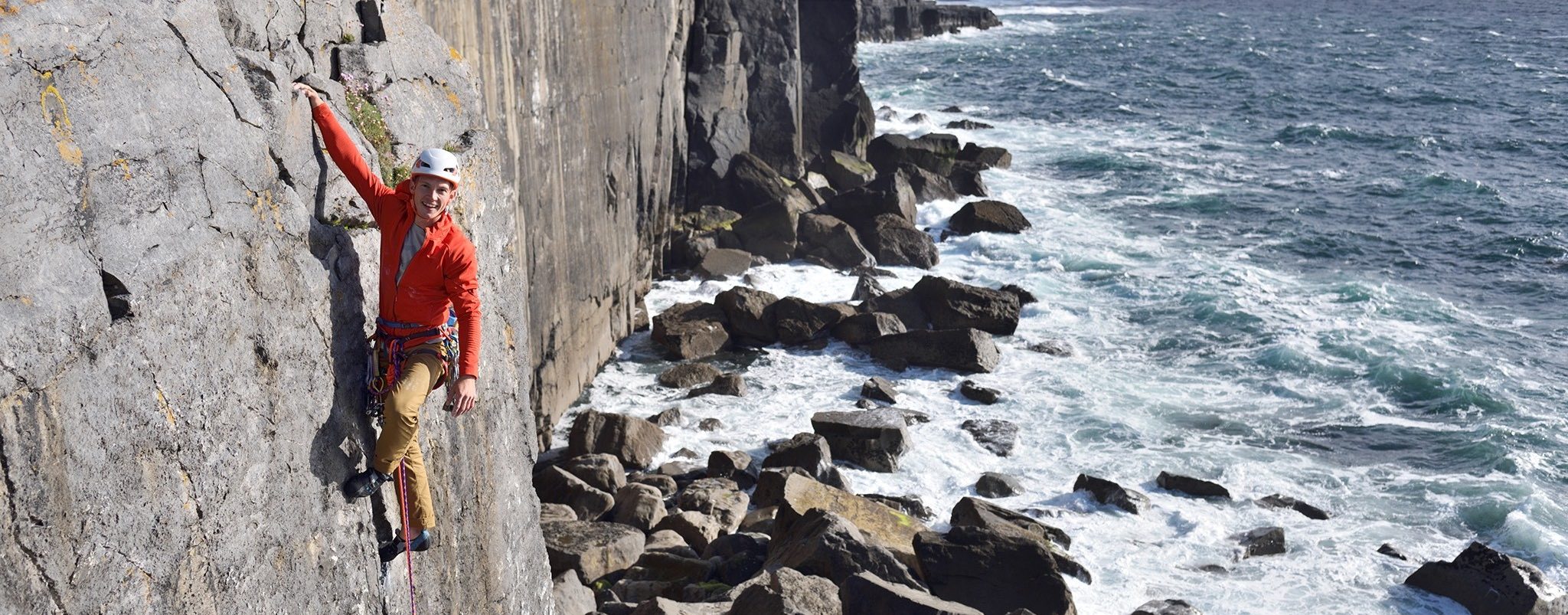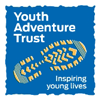Angus Kille, one of the UK’s best trad climbers offers up some top tips when tying into the sharp end…
I’ve given and received a lot of advice over the years on how to improve in trad climbing. When I was fourteen, my gear started ripping out of a belay on a sea cliff and an instructor working nearby kindly came over to explain what ‘equalising’ was. When I was twenty-one, I learnt that I should read a guidebook properly after I missed a crucial peg on an E5, and sketched through a run-out* I won’t forget. When I was twenty-seven, I tried to lay-back an entire crack pitch in Yosemite and ran out of cams halfway up before my climbing partner stopped laughing and taught me to crack climb efficiently.
The advice you get from climbers comes in all forms: sometimes it’s very safety specific, some of it is general guidance and good tactics, and some of it is simply great route recommendations. But after twelve years of ambitiously trying to improve my trad climbing, I’ve got five tips that are still relevant to me today.
* Run-out – the distance you go above your last point of protection when on lead.
1. Climb loads
There is a very strong correlation between doing lots of climbing and getting better at climbing. Most of my steps forward in climbing can be put down to simply doing more, often because I’ve made a lifestyle change, like getting a car or moving to a climbing area. Not all of us are fortunate enough to build a lifestyle around climbing, and instead it has to be squeezed into the busy lifestyles we already have. But the good news is that any climbing is likely to improve your trad climbing, even just a quick evening session at the wall.
If you can, sample as many different climbing styles as you can. Variety is one of the greatest things about climbing – there are so many different rock types, disciplines, gradients, environments and even partners to challenge yourself with, you’ll always find a weakness to work on.
That being said, if it’s trad you want to improve at, there’s no replacement for putting your trad rack to use on real rock, since placing gear on lead is such a specific skill that can only come from experience. Being fitter and stronger might give you more time and make hard moves feel more comfortable, but you still need to spend time on leader-placed protection to be a good trad climber. Fortunately, this means doing lots of climbing, which happens to be really good fun.
2. Learn to place good gear, and trust it!
This is what most people think of when they think about improving on trad, but there are still plenty of misconceptions around good gear placement. Our intuitions and fear tell us to throw pieces in whenever we get a bit scared, but we’re better off selecting the best placements and moving efficiently between them. I often work with climbers who are overwhelmed by a selection of mostly bad gear placements, it takes both a good understanding of gear and experience using it to select the good protection amongst them.
Having a structured way to evaluate your protection can be a useful way to make sure you’re placing gear well. A good example is rating each anchor* in a belay out of 5, then making sure your belay adds up to 10. It’s also important to have up-to-date advice from instructors and manufacturers – slings aren’t dynamic, cams can walk and all your soft kit has a melting point.
Learning to trust your gear is arguably a bigger step – so many trad climbers know how gear works in theory but don’t have any experience of testing it. When fear hits you, you need more than theoretical ideas about gear to feel safe above it; a Wallnut No.1 gets a load rating of 7kN, but this will feel pretty abstract when you’re a few metres out from it.
My advice is to start small: committing your weight to your belay, abseiling from gear and resting on gear all helps to build trust in your equipment. Taking a ‘top-rope fall’ on a cam placed above your head on lead is a huge step towards trusting gear and being a more confident trad climber.
This brings me perfectly onto my next tip:
* Anchor – each part of a belay that ‘anchors’ the party to the rock, for example a nut or a thread.
3. Don’t push it too far
It’s all too common to think that climbing should be hard, should be challenging and you should be pushing yourself a bit further. But if you’re ambitious about your climbing, the best way to progress is to start in your comfort zone and work into your ‘push’ zone – where you feel uncomfortable but well challenged. This is where we want our adventures to happen. Pushing it too far will create a negative experience and reinforce your fear around trad climbing and falling – people don’t overcome their fear of falling by getting scared witless on an E6.
So warm up on easy stuff, rest on gear if you need to, bail out if the weather turns bad and don’t play up to anyone else’s expectations. Get loads of experience on easier ground and build up to the more committing stuff when you feel ready. Whatever your preconceptions about hard climbing are, climbing doesn’t need to be dangerous, but it really should be fun. I’ve definitely had mixed ideas about this, but at the end of the day, being dangerous isn’t actually that cool.
4. Do what inspires you
This might seem obvious but we’re often motivated for the wrong reasons. If there’s a climbing photo that always inspired you, or a story that sparked your imagination, or the view of a route that made you become a climber – they are great motivations for climbing. But most climbers are affected by what other people expect of their climbing more often than they will admit, and end up being motivated by what they’ve been told is cool, hard or ‘good style’. But there’s no need to commit to onsighting* something if that’s not what inspires you. If you’re on a run-out because your mates think it’s a good idea, or because you’ll get some credit for it on social media, you’ll be in a really bad position to deal with that fear and in the long run it won’t be that rewarding.
However, if you’re intrinsically motivated, you can enjoy climbing even if you don’t succeed. There’s nothing quite like being on that route that inspired you to climb, or one of the routes that made you wonder “Can I do that?” when you saw a picture of it in a magazine or online. One of the most satisfying experiences we can have as climbers is doing something we didn’t know we could do, it gives us a new perspective on what we think is ‘possible’ for us.
So if you saw a cool video about sea cliff climbing, looked up at Dinas Cromlech* the first time you visited North Wales, or saw an amazing photo of the Cuillin Ridge* and decided that any of those things are cool, that’s a perfect reason to go out and do them.
* Onsighting – a style of ascent (considered ‘good style’) where the climber has no knowledge of the route before attempting it, and simply climbs it ‘on sight’ on their first attempt.
* Dinas Cromlech – an impressive crag on the north side of Llanberis Pass with classic routes of almost every grade.
* Cuillin Ridge – an iconic 12km alpine-style ridge line on the Isle of Skye, Scotland.
5. Learn from other people
Whether they’re your peers, instructors, pro climbers, or even people that don’t climb as ‘hard’ as you – you’ve probably got something to learn from everyone.
About a decade ago, I thought I knew everything I needed to know about climbing. Now I know that I’ll be a better climber if I focus on what I can learn from other people, not on what they can learn from me. I also have more fun, because I’m glad when I learn something new and occasionally I can even leave my ego out of it.
Another important point here is that there are black-and-white bits of knowledge that we can learn from the internet and textbooks, which should very much inform our decisions. However, climbing is full of judgements that are by no means black or white and require experience which is hard-earned. Learning from someone experienced will help make sense of that grey area, like when extending a bit of gear may have adverse consequences, or clipping an anchor in your belay might be ill-advised.
As it happens, climbers tend to be pretty friendly folk and they’re usually happy to help out someone less experienced. So make the most of what you can learn from peers, professionals and punters, you’ll improve quicker and you’ll probably enjoy climbing more.
–
Most of all, if you want to get the most out of trad climbing either as a leader or as a second, make sure you’re having fun. Some adventures are only fun once you’ve made it back, others a fun from the moment you start making plans. But as long as you’re staying safe, learning something every time you go out and enjoying the adventure, you’re probably on the right track!
How can we help you improve?
Angus Kille
Angus is an MCI climbing instructor with a passion for very hard rock climbing, he is also a good friend and freelance Mountaineering & Climbing Instructor for Mountain Expeditions.
He has 12 years’ experience of climbing around the world, ranging from the mountain crags of North Wales (where he lives just down the road from us) to unclimbed big walls in Brazil. Angus’s achievements in climbing include free climbing El Capitan in Yosemite, redpointing multiple 8c’s in Spain and making rare ascents of British E9’s such as Indian Face – an infamous slab climb on Clogwyn D’ur Arddu, North Wales – the first E9 in Britain!
The mix of his climbing abilities, unprecedented passion for rock climbing and his calm and friendly instructing approach makes Angus a firm favourite for many clients. You can follow him on Instagram and Facebook.

Next article – 3 top tips for becoming a jedi second







